The Discus Thrower(掷铁饼者)
- 格式:pptx
- 大小:1.22 MB
- 文档页数:30
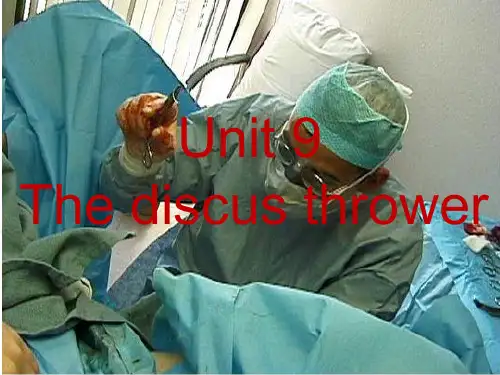
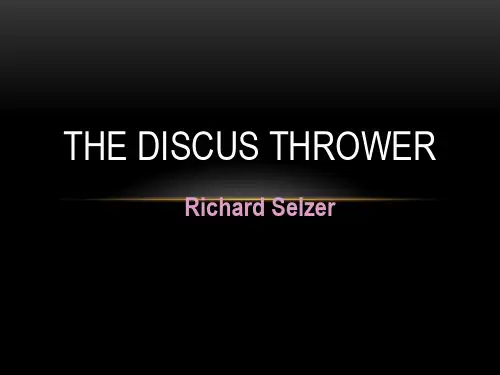
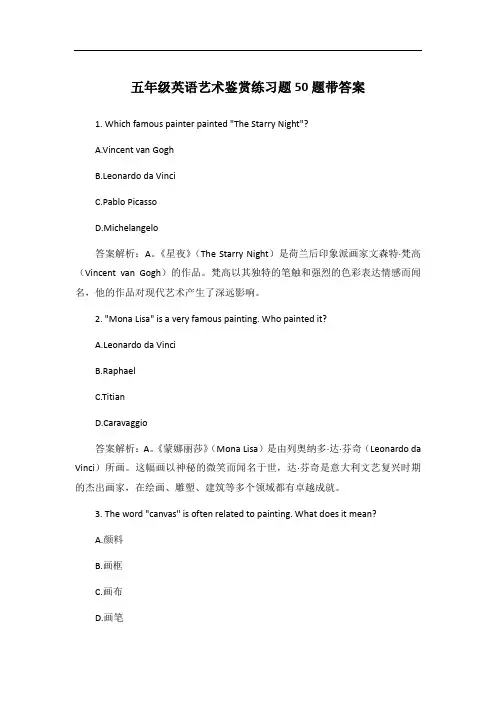
五年级英语艺术鉴赏练习题50题带答案1. Which famous painter painted "The Starry Night"?A.Vincent van GoghB.Leonardo da VinciC.Pablo PicassoD.Michelangelo答案解析:A。
《星夜》(The Starry Night)是荷兰后印象派画家文森特·梵高(Vincent van Gogh)的作品。
梵高以其独特的笔触和强烈的色彩表达情感而闻名,他的作品对现代艺术产生了深远影响。
2. "Mona Lisa" is a very famous painting. Who painted it?A.Leonardo da VinciB.RaphaelC.TitianD.Caravaggio答案解析:A。
《蒙娜丽莎》(Mona Lisa)是由列奥纳多·达·芬奇(Leonardo da Vinci)所画。
这幅画以神秘的微笑而闻名于世,达·芬奇是意大利文艺复兴时期的杰出画家,在绘画、雕塑、建筑等多个领域都有卓越成就。
3. The word "canvas" is often related to painting. What does it mean?A.颜料B.画框C.画布D.画笔答案解析:C。
“canvas”的意思是“画布”。
在绘画中,画布是画家作画的重要载体,画家在画布上涂抹颜料来创作画作。
4. Which of the following is a painting by Claude Monet?A."Water Lilies"B."The Scream"C."Guernica"D."The Persistence of Memory"答案解析:A。
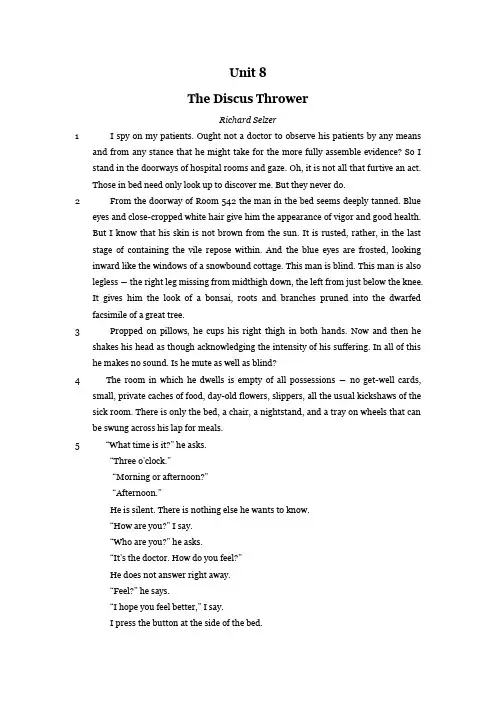
Unit 8The Discus ThrowerRichard Selzer1 I spy on my patients. Ought not a doctor to observe his patients by any meansand from any stance that he might take for the more fully assemble evidence? So I stand in the doorways of hospital rooms and gaze. Oh, it is not all that furtive an act.Those in bed need only look up to discover me. But they never do.2 From the doorway of Room 542 the man in the bed seems deeply tanned. Blueeyes and close-cropped white hair give him the appearance of vigor and good health.But I know that his skin is not brown from the sun. It is rusted, rather, in the last stage of containing the vile repose within. And the blue eyes are frosted, looking inward like the windows of a snowbound cottage. This man is blind. This man is also legless ― the right leg missing from midthigh down, the left from just below the knee.It gives him the look of a bonsai, roots and branches pruned into the dwarfed facsimile of a great tree.3 Propped on pillows, he cups his right thigh in both hands. Now and then heshakes his head as though acknowledging the intensity of his suffering. In all of this he makes no sound. Is he mute as well as blind?4 The room in which he dwells is empty of all possessions ― no get-well cards,small, private caches of food, day-old flowers, slippers, all the usual kickshaws of the sick room. There is only the bed, a chair, a nightstand, and a tray on wheels that can be swung across his lap for meals.5 “What time is it?” he asks.“Three o’clock.”“Morning or afternoon?”“Afternoon.”He is silent. There is nothing else he wants to know.“How are you?” I say.“Who are you?” he asks.“It’s the doctor. How do you feel?”He does not answer right away.“Feel?” he says.“I hope you feel better,” I say.I press the button at the side of the bed.“Down you go,” I say.“Yes, down,” he says.6 He falls back upon the bed awkwardly. His stumps, unweighted by legs and feet,rise in the air, presenting themselves. I unwrap the bandages from the stumps, and begin to cut away the black scabs and the dead, glazed fat with scissors and forceps.A shard of white bone comes loose. I pick it away. I wash the wounds withdisinfectant and redress the stumps. All this while, he does not speak. What is he thinking behind those lids that do not blink? Is he remembering a time when he was whole? Does he dream of feet? Or when his body was not a rotting log?7 He lies solid and inert. In spite of everything, he remains impressive, as thoughhe were a sailor standing athwart a slanting deck.“Anything more I can do for you?” I ask.For a long moment he is silent.“Yes,” he says at last and without the least irony. “You can bring me a pair of shoes.”In the corridor, the head nurse is waiting for me.“We have to do something about him,” she says. “Every morning he orders scrambled eggs for breakfast, and, instead of eating them, he picks up the plate and throws it against the wall.”“Throws his plate?”“Nasty. That’s what he is. No wonder his family doesn’t come to visit. They probably can’t stand him any more than we can.”She is waiting for me to do something.“Well?”“We’ll see,” I say.8 The next morning I am waiting in the corridor when the kitchen delivers hisbreakfast. I watch the aide place the tray on the stand and swing it across his lap. She presses the button to raise the head of the bed. Then she leaves.9 In time the man reaches to find the rim of the tray, then on to find the dome ofthe covered dish. He lifts off the cover and places it on the stand. He fingers across the plate until he probes the eggs. He lifts the plate in both hands, sets it on the palm of his right hand, centers it, balances it. He hefts it up and down slightly, getting the feel on it. Abruptly, he draws back his right arm as far as he can.10 There is the crack of the plate breaking against the wall at the foot of his bed andthe small wet sound of the scrambled eggs dropping to the floor.11 And then he laughs. It is a sound you have never heard. It is something newunder the sun. It could cure cancer.Out in the corridor, the eyes of the head nurse narrow.“Laughed, did he?”She writes something down on her clipboard.12 A second aide arrives, brings a second breakfast tray, puts it on the nightstand,out of his reach. She looks over at me shaking her head and making her mouth go. I see that we are to be accomplices.13 “I’ve got to feed you,” she says to the man.“Oh, no, you don’t,” the man says.“Oh, yes, I do,” the aide says, “after the way you just did. Nurse says so.”“Get me my shoes,” the man says.“Here’s the oatmeal,” the aide says. “Open.” And she touches the spoon to his lower lip.“I ordered scrambled eggs,” says the man.“That’s right,” the aide says.I step forward.“Is there anything I can do?” I say.“Who are you?” the man asks.14 In the evening I go once more to that ward to make my rounds. The head nursereports to me that Room 542 is deceased. She has discovered this by accident, she says. No, there had been no sound. Nothing. It’s a ble ssing, she says.15 I go into his room, a spy looking for secrets. He is still there in his bed. His faceis relaxed, grave, dignified. After a while, I turn to leave. My gaze sweeps the wall at the foot of the bed, and I see the place where it has been repeatedly washed, where the wall looks very clean and white.掷铁饼者理查德·塞尔泽1 我窥探我的病人。
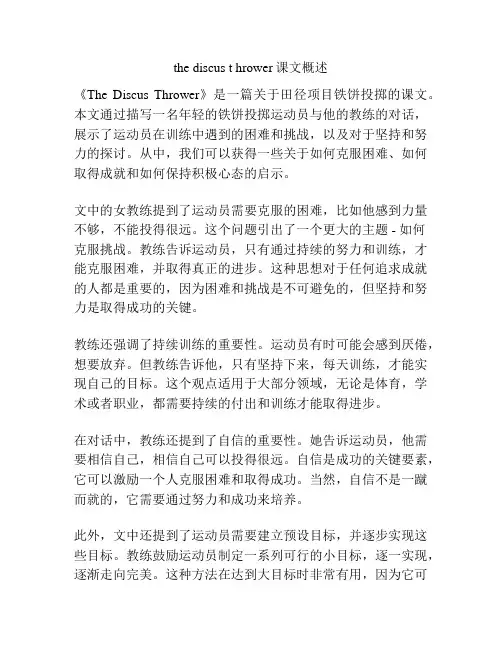
the discus t hrower课文概述《The Discus Thrower》是一篇关于田径项目铁饼投掷的课文。
本文通过描写一名年轻的铁饼投掷运动员与他的教练的对话,展示了运动员在训练中遇到的困难和挑战,以及对于坚持和努力的探讨。
从中,我们可以获得一些关于如何克服困难、如何取得成就和如何保持积极心态的启示。
文中的女教练提到了运动员需要克服的困难,比如他感到力量不够,不能投得很远。
这个问题引出了一个更大的主题 - 如何克服挑战。
教练告诉运动员,只有通过持续的努力和训练,才能克服困难,并取得真正的进步。
这种思想对于任何追求成就的人都是重要的,因为困难和挑战是不可避免的,但坚持和努力是取得成功的关键。
教练还强调了持续训练的重要性。
运动员有时可能会感到厌倦,想要放弃。
但教练告诉他,只有坚持下来,每天训练,才能实现自己的目标。
这个观点适用于大部分领域,无论是体育,学术或者职业,都需要持续的付出和训练才能取得进步。
在对话中,教练还提到了自信的重要性。
她告诉运动员,他需要相信自己,相信自己可以投得很远。
自信是成功的关键要素,它可以激励一个人克服困难和取得成功。
当然,自信不是一蹴而就的,它需要通过努力和成功来培养。
此外,文中还提到了运动员需要建立预设目标,并逐步实现这些目标。
教练鼓励运动员制定一系列可行的小目标,逐一实现,逐渐走向完美。
这种方法在达到大目标时非常有用,因为它可以帮助人们保持动力和专注,同时也减轻了目标过于庞大带来的压力。
通过本文,我们可以得出一些启示。
首先,克服困难和挑战需要持续的坚持和努力。
只有通过不断练习和训练,才能取得进步。
其次,自信是成功的关键,它可以激励人们克服困难和实现目标。
第三,明确的目标和逐步实现的计划对于成功起到了关键作用。
总之,《The Discus Thrower》这篇课文通过对话的形式,向读者展示了铁饼投掷运动员在训练中所面临的困难和挑战。
通过教练的指导和运动员的努力,我们看到了如何克服困难,取得进步,并最终达到自己的目标。
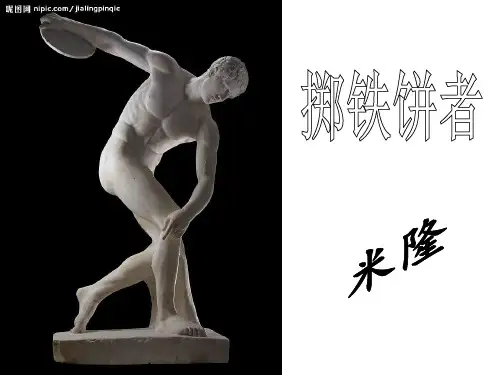
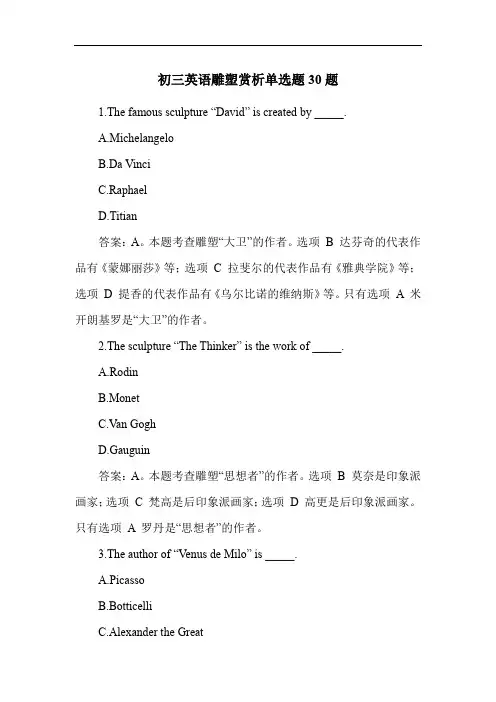
初三英语雕塑赏析单选题30题1.The famous sculpture “David” is created by _____.A.MichelangeloB.Da VinciC.RaphaelD.Titian答案:A。
本题考查雕塑“大卫”的作者。
选项B 达芬奇的代表作品有《 蒙娜丽莎》等;选项C 拉斐尔的代表作品有《 雅典学院》等;选项D 提香的代表作品有《 乌尔比诺的维纳斯》等。
只有选项 A 米开朗基罗是“大卫”的作者。
2.The sculpture “The Thinker” is the work of _____.A.RodinB.MonetC.Van GoghD.Gauguin答案:A。
本题考查雕塑“思想者”的作者。
选项B 莫奈是印象派画家;选项C 梵高是后印象派画家;选项D 高更是后印象派画家。
只有选项A 罗丹是“思想者”的作者。
3.The author of “Venus de Milo” is _____.A.PicassoB.BotticelliC.Alexander the GreatD.an unknown ancient Greek sculptor答案:D。
本题考查“米洛斯的维纳斯”的作者。
选项A 毕加索是现代派画家;选项B 波提切利是文艺复兴早期画家;选项C 亚历山大大帝不是雕塑家。
“米洛斯的维纳斯”的作者至今未知,是古希腊的一位雕塑家创作的。
4.The sculpture “The Discus Thrower” is made by _____.A.PlatoB.AristotleC.MyronD.Socrates答案:C。
本题考查雕塑“掷铁饼者”的作者。
选项A 柏拉图是哲学家;选项B 亚里士多德是哲学家;选项D 苏格拉底是哲学家。
只有选项C 米隆是“掷铁饼者”的作者。
5.The creator of “The Gates of Hell” is _____.A.RenoirB.CezanneC.RodinD.Matisse答案:C。
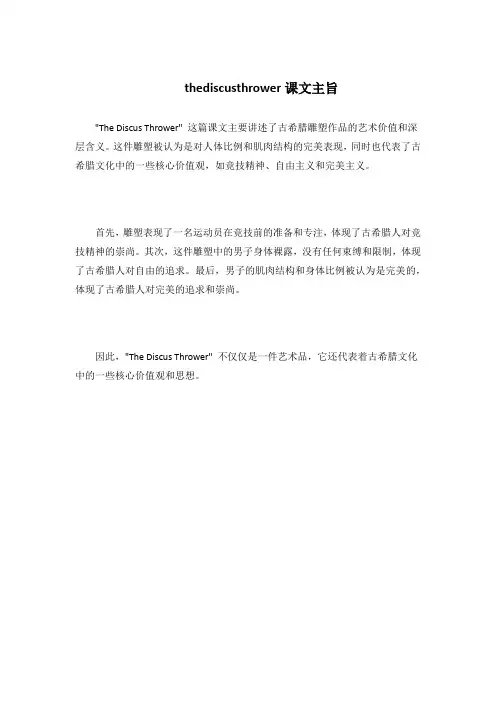
thediscusthrower课文主旨
"The Discus Thrower" 这篇课文主要讲述了古希腊雕塑作品的艺术价值和深层含义。
这件雕塑被认为是对人体比例和肌肉结构的完美表现,同时也代表了古希腊文化中的一些核心价值观,如竞技精神、自由主义和完美主义。
首先,雕塑表现了一名运动员在竞技前的准备和专注,体现了古希腊人对竞技精神的崇尚。
其次,这件雕塑中的男子身体裸露,没有任何束缚和限制,体现了古希腊人对自由的追求。
最后,男子的肌肉结构和身体比例被认为是完美的,体现了古希腊人对完美的追求和崇尚。
因此,"The Discus Thrower" 不仅仅是一件艺术品,它还代表着古希腊文化中的一些核心价值观和思想。
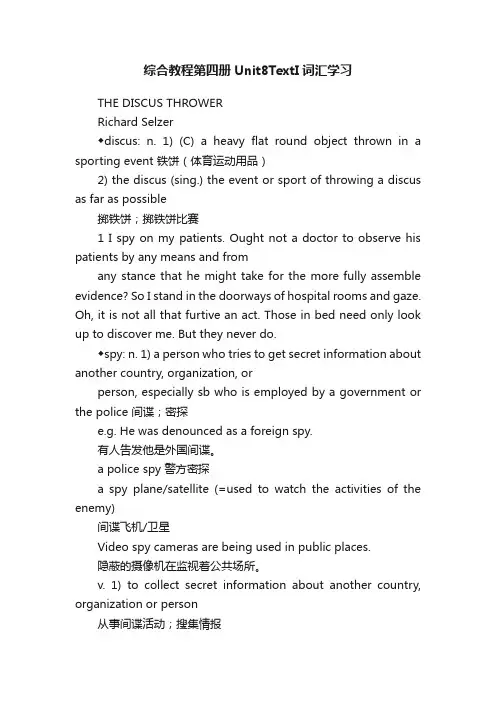
综合教程第四册Unit8TextI词汇学习THE DISCUS THROWERRichard Selzer◆discus: n. 1) (C) a heavy flat round object thrown in a sporting event 铁饼(体育运动用品)2) the discus (sing.) the event or sport of throwing a discus as far as possible掷铁饼;掷铁饼比赛1 I spy on my patients. Ought not a doctor to observe his patients by any means and fromany stance that he might take for the more fully assemble evidence? So I stand in the doorways of hospital rooms and gaze. Oh, it is not all that furtive an act. Those in bed need only look up to discover me. But they never do.◆spy: n. 1) a person who tries to get secret information about another country, organization, orperson, especially sb who is employed by a government or the police 间谍;密探e.g. He was denounced as a foreign spy.有人告发他是外国间谍。
a police spy 警方密探a spy plane/satellite (=used to watch the activities of the enemy)间谍飞机/卫星Video spy cameras are being used in public places.隐蔽的摄像机在监视着公共场所。

理查德塞尔泽掷铁饼者读后感英文回答:Richard Sears, the discus thrower, is an inspiringfigure who has left a deep impression on me. His dedication, perseverance, and passion for his sport are truly admirable. When reading about his journey, I couldn't help but be captivated by his incredible achievements and thechallenges he faced along the way.One aspect of Richard Sears' story that struck me washis unwavering commitment to his craft. Despite facing numerous setbacks and obstacles, he never gave up on his dream of becoming a successful discus thrower. This resilience is something that I greatly admire and aspire to emulate in my own life. It serves as a reminder thatsuccess often requires hard work, determination, and the ability to overcome adversity.Another aspect of Sears' story that resonated with mewas the importance of setting goals and consistently working towards them. Sears had a clear vision of what he wanted to achieve and he took deliberate steps to make it happen. He constantly pushed himself to improve his technique, strength, and mental focus. This level of dedication and discipline is something that I find incredibly inspiring and it has motivated me to set my own goals and work towards them with unwavering determination.Furthermore, Sears' story highlights the significance of having a strong support system. Throughout his journey, he had coaches, teammates, and family members who believed in him and supported him every step of the way. This sense of community and encouragement played a crucial role in his success. It serves as a reminder that we are not alone in our pursuits and that having a support system can make all the difference in achieving our goals.In addition, Sears' story also sheds light on the importance of perseverance and patience. He faced numerous setbacks and disappointments, but he never let them deter him from his ultimate goal. Instead, he used thesechallenges as opportunities to learn and grow. This ability to bounce back from failure is something that I find incredibly inspiring and it has taught me the importance of resilience in the face of adversity.Overall, Richard Sears' story has left a lasting impact on me. His dedication, perseverance, and passion for his sport serve as a reminder of the power of hard work and determination. His journey has inspired me to set goals, push myself beyond my limits, and never give up on my dreams. I am grateful for the opportunity to learn from his experiences and I am excited to apply these lessons to my own life.中文回答:理查德·塞尔泽,这位铁饼投掷者,是一个令我深感敬佩的人物。

the discus thrower课文主旨大意
《掷铁饼者》这篇课文主要讲述了一个濒临死亡的年老患者在心灵与肉体遭受双重折磨的苦难中,试图保持尊严的故事。
故事的开始是医生以叙述者的身份悄悄地观察躺在医院的病床上一位年老患者。
这位病人形象与古希腊雕塑《掷铁饼者》形成鲜明对比。
古希腊雕塑赞美了人体的美和运动所饱含的生命力,被看作古希腊雕塑美的典范。
作者用它做题目来描写一个肢体残缺的老者,旨在刻画出老者在苦难中仍试图保持尊严的形象。
以上内容仅供参考,建议查阅《掷铁饼者》课文原文,获取更准确的信息。
理查德塞尔泽掷铁饼者读后感英文版"The Disc Thrower" by Richard Seltzer: A ReflectionRichard Seltzer's "The Disc Thrower" left me profoundly moved, not just by the artist's exceptional skill but also by the deeper meanings embedded within the piece. The sculpture, a masterpiece of realism, captures the essence of a moment in the life of an athlete, frozen in the act of throwing a discus. It's a moment of pure concentration, of powerful effort, and of absolute grace.The athlete's body is twisted and contorted, every muscle taut with the force of the throw. His gaze is fixed ahead, his expression intense, as if he is willing the discus to reach its maximum distance. The pose is dynamically balanced, with the athlete's weight shifted to the rear leg, providing stability for the powerful thrust of the body and the arm.But what really struck me about this sculpture is the sense of motion it conveys. The discus, in mid-flight, seems to be suspended in air, its path traced by the athlete's outstretched arm. The whole scene is full of tension and dynamism, as if we are watching a movie in fast-forward, seeing only the most critical moment.But "The Disc Thrower" is not just about the athlete's strength and skill. It's also about the human spirit, the determination to push oneself to the limit, to achieve the impossible. The athlete's body, twisted and contorted, is a testament to the human capacity for endurance and sacrifice. His gaze, fixed ahead, is a symbol of the unwavering commitment to excellence.Richard Seltzer's sculpture is not just a representation of a specific moment in an athlete's life. It's a universal symbol of human potential, of the limitless possibilities that lie within each of us. It's a reminder that, with enough dedication and effort, we can all achieve greatness.中文版《理查德塞尔泽的“掷铁饼者”读后感》理查德·塞尔泽的《掷铁饼者》让我深受触动,这不仅是因为艺术家超凡的技巧,更因为作品中蕴含的深刻意义。
Unit 8The Discus ThrowerRichard Selzer1 I spy on my patients. Ought not a doctor to observe his patients by any meansand from any stance that he might take for the more fully assemble evidence? So I stand in the doorways of hospital rooms and gaze. Oh, it is not all that furtive an act.Those in bed need only look up to discover me. But they never do.2 From the doorway of Room 542 the man in the bed seems deeply tanned. Blueeyes and close-cropped white hair give him the appearance of vigor and good health.But I know that his skin is not brown from the sun. It is rusted, rather, in the last stage of containing the vile repose within. And the blue eyes are frosted, looking inward like the windows of a snowbound cottage. This man is blind. This man is also legless ― the right leg missing from midthigh down, the left from just below the knee.It gives him the look of a bonsai, roots and branches pruned into the dwarfed facsimile of a great tree.3 Propped on pillows, he cups his right thigh in both hands. Now and then heshakes his head as though acknowledging the intensity of his suffering. In all of this he makes no sound. Is he mute as well as blind?4 The room in which he dwells is empty of all possessions ― no get-well cards,small, private caches of food, day-old flowers, slippers, all the usual kickshaws of the sick room. There is only the bed, a chair, a nightstand, and a tray on wheels that can be swung across his lap for meals.5 “What time is it?” he asks.“Three o’clock.”“Morning or afternoon?”“Afternoon.”He is silent. There is nothing else he wants to know.“How are you?” I say.“Who are you?” he asks.“It’s the doctor. How do you feel?”He does not answer right away.“Feel?” he says.“I hope you feel better,” I say.I press the button at the side of the bed.“Down you go,” I say.“Yes, down,” he says.6 He falls back upon the bed awkwardly. His stumps, unweighted by legs and feet,rise in the air, presenting themselves. I unwrap the bandages from the stumps, and begin to cut away the black scabs and the dead, glazed fat with scissors and forceps.A shard of white bone comes loose. I pick it away. I wash the wounds withdisinfectant and redress the stumps. All this while, he does not speak. What is he thinking behind those lids that do not blink? Is he remembering a time when he was whole? Does he dream of feet? Or when his body was not a rotting log?7 He lies solid and inert. In spite of everything, he remains impressive, as thoughhe were a sailor standing athwart a slanting deck.“Anything more I can do for you?” I ask.For a long moment he is silent.“Yes,” he says at last and without the least irony. “You can bring me a pair of shoes.”In the corridor, the head nurse is waiting for me.“We have to do something about him,” she says. “Every morning he orders scrambled eggs for breakfast, and, instead of eating them, he picks up the plate and throws it against the wall.”“Throws his plate?”“Nasty. That’s what he is. No wonder his family doesn’t come to visit. They probably can’t stand him any more than we can.”She is waiting for me to do something.“Well?”“We’ll see,” I say.8 The next morning I am waiting in the corridor when the kitchen delivers hisbreakfast. I watch the aide place the tray on the stand and swing it across his lap. She presses the button to raise the head of the bed. Then she leaves.9 In time the man reaches to find the rim of the tray, then on to find the dome ofthe covered dish. He lifts off the cover and places it on the stand. He fingers across the plate until he probes the eggs. He lifts the plate in both hands, sets it on the palm of his right hand, centers it, balances it. He hefts it up and down slightly, getting the feel on it. Abruptly, he draws back his right arm as far as he can.10 There is the crack of the plate breaking against the wall at the foot of his bed andthe small wet sound of the scrambled eggs dropping to the floor.11 And then he laughs. It is a sound you have never heard. It is something newunder the sun. It could cure cancer.Out in the corridor, the eyes of the head nurse narrow.“Laughed, did he?”She writes something down on her clipboard.12 A second aide arrives, brings a second breakfast tray, puts it on the nightstand,out of his reach. She looks over at me shaking her head and making her mouth go. I see that we are to be accomplices.13 “I’ve got to feed you,” she says to the man.“Oh, no, you don’t,” the man says.“Oh, yes, I do,” the aide says, “after the way you just did. Nurse says so.”“Get me my shoes,” the man says.“Here’s the oatmeal,” the aide says. “Open.” And she touches the spoon to his lower lip.“I ordered scrambled eggs,” says the man.“That’s right,” the aide says.I step forward.“Is there anything I can do?” I say.“Who are you?” the man asks.14 In the evening I go once more to that ward to make my rounds. The head nursereports to me that Room 542 is deceased. She has discovered this by accident, she says. No, there had been no sound. Nothing. It’s a ble ssing, she says.15 I go into his room, a spy looking for secrets. He is still there in his bed. His faceis relaxed, grave, dignified. After a while, I turn to leave. My gaze sweeps the wall at the foot of the bed, and I see the place where it has been repeatedly washed, where the wall looks very clean and white.掷铁饼者理查德·塞尔泽1 我窥探我的病人。
Unit 8The Discus ThrowerRichard Selzer1 I spy on my patients. Ought not a doctor to observe his patients by any meansand from any stance that he might take for the more fully assemble evidence? So I stand in the doorways of hospital rooms and gaze. Oh, it is not all that furtive an act.Those in bed need only look up to discover me. But they never do.2 From the doorway of Room 542 the man in the bed seems deeply tanned. Blueeyes and close-cropped white hair give him the appearance of vigor and good health.But I know that his skin is not brown from the sun. It is rusted, rather, in the last stage of containing the vile repose within. And the blue eyes are frosted, looking inward like the windows of a snowbound cottage. This man is blind. This man is also legless ― the right leg missing from midthigh down, the left from just below the knee.It gives him the look of a bonsai, roots and branches pruned into the dwarfed facsimile of a great tree.3 Propped on pillows, he cups his right thigh in both hands. Now and then heshakes his head as though acknowledging the intensity of his suffering. In all of this he makes no sound. Is he mute as well as blind?4 The room in which he dwells is empty of all possessions ― no get-well cards,small, private caches of food, day-old flowers, slippers, all the usual kickshaws of the sick room. There is only the bed, a chair, a nightstand, and a tray on wheels that can be swung across his lap for meals.5 “What time is it?” he asks.“Three o’clock.”“Morning or afternoon?”“Afternoon.”He is silent. There is nothing else he wants to know.“How are you?” I say.“Who are you?” he asks.“It’s the doctor. How do you feel?”He does not answer right away.“Feel?” he says.“I hope you feel better,” I say.I press the button at the side of the bed.“Down you go,” I say.“Yes, down,” he says.6 He falls back upon the bed awkwardly. His stumps, unweighted by legs and feet,rise in the air, presenting themselves. I unwrap the bandages from the stumps, and begin to cut away the black scabs and the dead, glazed fat with scissors and forceps.A shard of white bone comes loose. I pick it away. I wash the wounds withdisinfectant and redress the stumps. All this while, he does not speak. What is he thinking behind those lids that do not blink? Is he remembering a time when he was whole? Does he dream of feet? Or when his body was not a rotting log?7 He lies solid and inert. In spite of everything, he remains impressive, as thoughhe were a sailor standing athwart a slanting deck.“Anything more I can do for you?” I ask.For a long moment he is silent.“Yes,” he says at last and without the least irony. “You can bring me a pair of shoes.”In the corridor, the head nurse is waiting for me.“We have to do something about him,” she says. “Every morning he orders scrambled eggs for breakfast, and, instead of eating them, he picks up the plate and throws it against the wall.”“Throws his plate?”“Nasty. That’s what he is. No wonder his family doesn’t come to visit. They probably can’t stand him any more than we can.”She is waiting for me to do something.“Well?”“We’ll see,” I say.8 The next morning I am waiting in the corridor when the kitchen delivers hisbreakfast. I watch the aide place the tray on the stand and swing it across his lap. She presses the button to raise the head of the bed. Then she leaves.9 In time the man reaches to find the rim of the tray, then on to find the dome ofthe covered dish. He lifts off the cover and places it on the stand. He fingers across the plate until he probes the eggs. He lifts the plate in both hands, sets it on the palm of his right hand, centers it, balances it. He hefts it up and down slightly, getting the feel on it. Abruptly, he draws back his right arm as far as he can.10 There is the crack of the plate breaking against the wall at the foot of his bed andthe small wet sound of the scrambled eggs dropping to the floor.11 And then he laughs. It is a sound you have never heard. It is something newunder the sun. It could cure cancer.Out in the corridor, the eyes of the head nurse narrow.“Laughed, did he?”She writes something down on her clipboard.12 A second aide arrives, brings a second breakfast tray, puts it on the nightstand,out of his reach. She looks over at me shaking her head and making her mouth go. I see that we are to be accomplices.13 “I’ve got to feed you,” she says to the man.“Oh, no, you don’t,” the man says.“Oh, yes, I do,” the aide says, “after the way you just did. Nurse says so.”“Get me my shoes,” the man says.“Here’s the oatmeal,” the aide says. “Open.” And she touches the spoon to his lower lip.“I ordered scrambled eggs,” says the man.“That’s right,” the aide says.I step forward.“Is there anything I can do?” I say.“Who are you?” the man asks.14 In the evening I go once more to that ward to make my rounds. The head nursereports to me that Room 542 is deceased. She has discovered this by accident, she says. No, there had been no sound. Nothing. It’s a bl essing, she says.15 I go into his room, a spy looking for secrets. He is still there in his bed. His faceis relaxed, grave, dignified. After a while, I turn to leave. My gaze sweeps the wall at the foot of the bed, and I see the place where it has been repeatedly washed, where the wall looks very clean and white.掷铁饼者理查德·塞尔泽1 我窥探我的病人。
掷铁饼者英文作文英文:As a discus thrower, I have learned a lot about the sport and the techniques that go into it. One of the most important things to remember when throwing the discus is to have a strong grip on the discus. This allows for better control and accuracy when throwing.Another important aspect of discus throwing is the footwork. It is important to have a solid foundation and to be able to transfer your weight from one foot to the other smoothly and quickly. This helps to generate more power and speed in the throw.In addition to these technical aspects, mental preparation is also crucial in discus throwing. It is important to stay focused and confident, even when facing tough competition or difficult conditions. Visualization techniques and positive self-talk can be helpful inmaintaining a strong mindset.Overall, discus throwing requires a combination of physical strength, technical skill, and mental toughness. It is a challenging but rewarding sport that requires dedication and hard work.中文:作为一个掷铁饼者,我学到了很多关于这项运动和其中涉及的技巧。
九年级英语艺术欣赏单选题40题1. Which of the following painters is known for his "Impressionist" paintings?A. Leonardo da VinciB. Vincent van GoghC. MichelangeloD. Pablo Picasso答案:B。
解析:Vincent van Gogh是印象派画家的代表人物之一。
Leonardo da Vinci是文艺复兴时期画家,以《 蒙娜丽莎》等作品闻名,他的风格不属于印象派;Michelangelo也是文艺复兴时期的重要艺术家,主要以雕塑和壁画等闻名;Pablo Picasso是现代派画家,创立了立体主义等多种风格。
本题考查对不同画家及其所属流派的了解,同时涉及到一些著名画家名字等词汇。
2. "The Starry Night" is a famous painting created by _.A. Claude MonetB. Edvard MunchC. Vincent van GoghD. Gustav Klimt答案:C。
解析: 星月夜》是梵高的著名画作。
Claude Monet是印象派画家,以 日出·印象》等为代表作;Edvard Munch的代表作是《 呐喊》;Gustav Klimt是奥地利象征主义画家。
这题考查对特定画作及其作者的认识,涉及到画作名称和画家名字等词汇。
3. Which painting style focuses on showing the momentary impression of light and color?A. CubismB. SurrealismC. ImpressionismD. Realism答案:C。
解析:印象派(Impressionism)着重于表现光线和色彩的瞬间印象。
小升初英语艺术作品赏析单选题50题1.Which painting is known for its use of bright colors and bold brushstrokes?A. Mona LisaB. The Starry NightC. The Last SupperD. Guernica答案:B。
本题考查对西方经典绘画作品特点的了解。
选项A《 蒙娜丽莎》以其神秘的微笑和细腻的笔触著称。
选项C《 最后的晚餐》侧重于宗教主题和人物表情的刻画。
选项D《 格尔尼卡》以其强烈的表现力和反战主题闻名。
而选项B《 星月夜》以其明亮的色彩和大胆的笔触为主要特点。
2.In which painting can you see a lot of people having a meal?A. The ScreamB. The Birth of VenusC. The Persistence of MemoryD. The Last Supper答案:D。
此题考查对绘画内容的熟悉程度。
选项A《呐喊》主要是表现一种惊恐的情绪。
选项B《 维纳斯的诞生》描绘的是维纳斯从海中诞生的场景。
选项C《 记忆的永恒》展现的是奇特的变形物体。
选项D 最后的晚餐》中能看到很多人在进餐。
3.Which painting shows a woman with a mysterious smile?A. The Sistine MadonnaB. Girl with a Pearl EarringC. Mona LisaD. American Gothic答案:C。
本题考查对著名画作中人物形象的认知。
选项A《西斯廷圣母》中的圣母形象庄重慈爱。
选项B《 戴珍珠耳环的少女》展现的是一位戴珍珠耳环的少女形象。
选项D《 美国哥特式》是一对农民夫妇的形象。
而选项C 蒙娜丽莎》以其神秘的微笑闻名于世。
4.Which of the following paintings is by Vincent van Gogh?A. SunflowersB. The Night WatchC. The Creation of AdamD. The Raft of the Medusa答案:A。